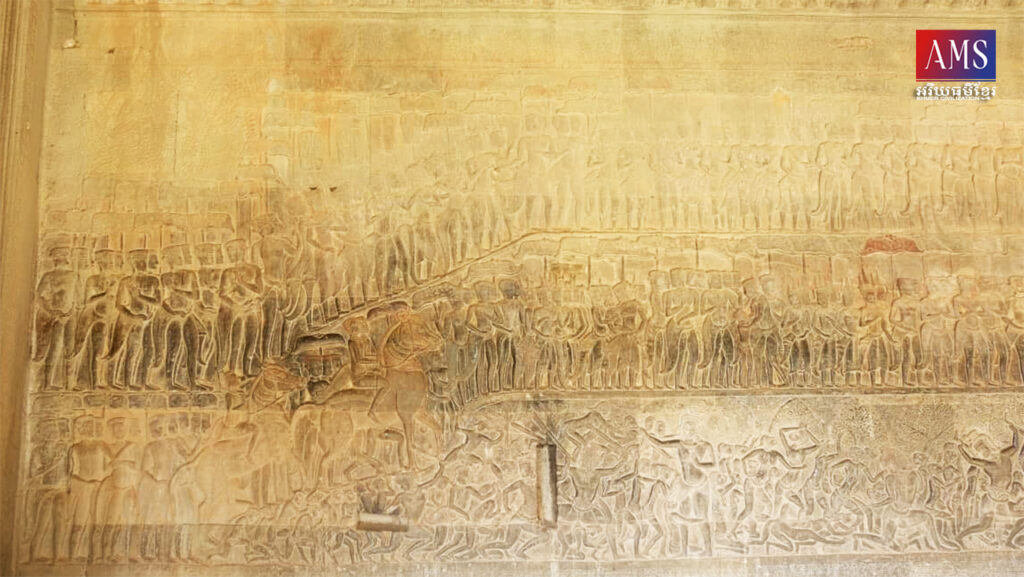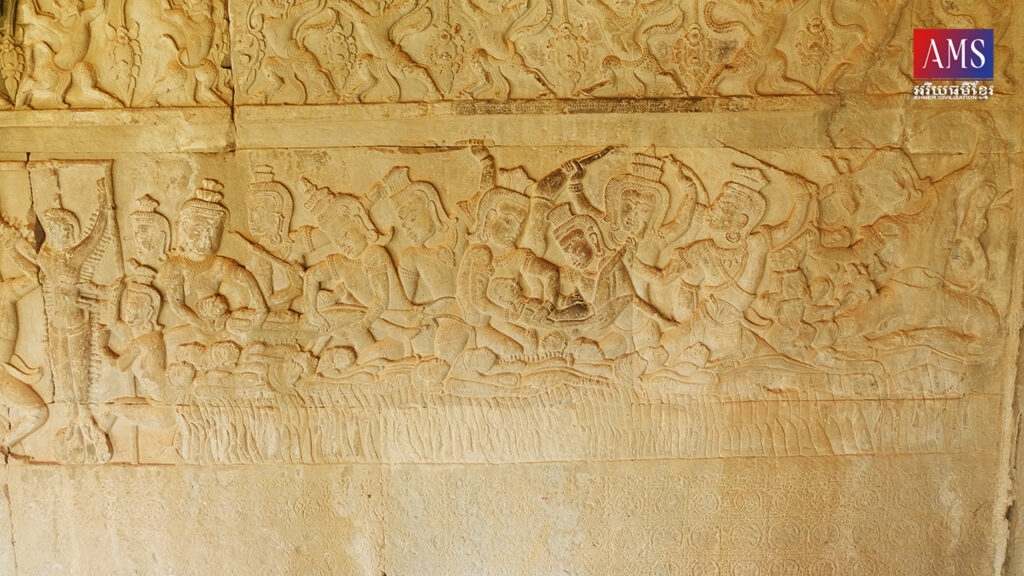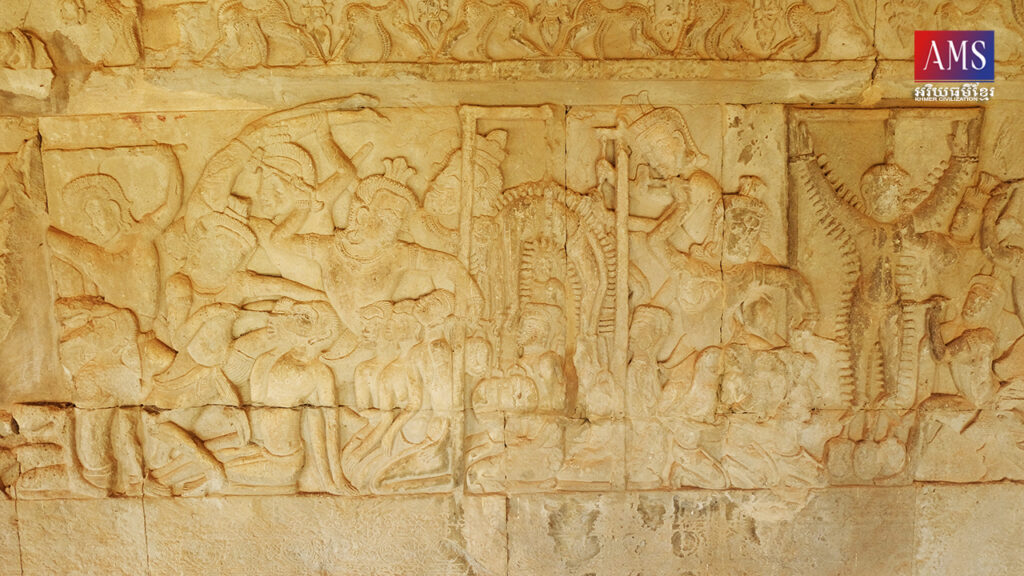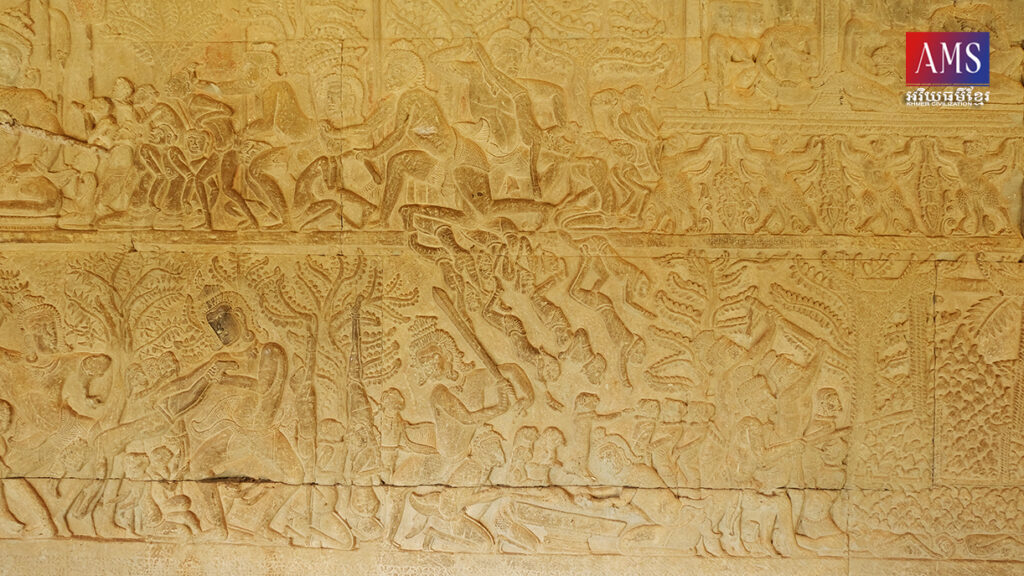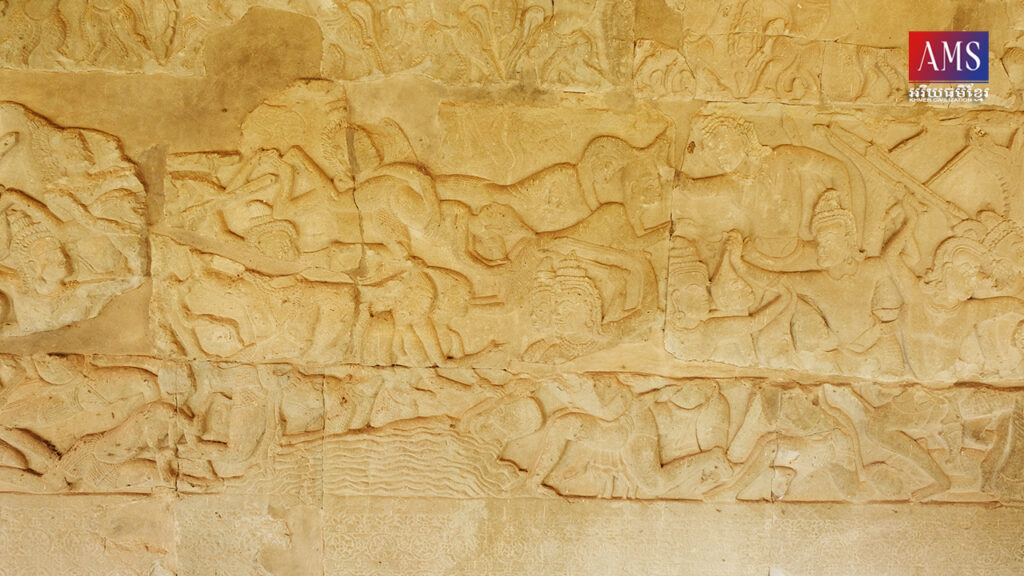សាសនាដទៃក្នុងលោកតែងបរិយាយរៀបរាប់អំពីនរក និងសួគ៌ ហើយជំនឿនេះគឺមានទំនាក់ទំនងយ៉ាងជិតស្និទ្ធទៅនឹងកម្មដែលមនុស្សបានប្រព្រឹត្តិកាលនៅរស់។ សម្រាប់ស្រុកខ្មែរដែលមានជំនឿតាមព្រះពុទ្ធសាសនា និងព្រហ្មញ្ញសាសានាផង គេជឿថាក្រោយពេលមនុស្សណាម្នាក់ស្លាប់ទៅ ព្រលឹងអ្នកនោះនឹងត្រូវនាំយកទៅនរក១៥ថ្ងៃដោយយម្ភូបាលដែលជាអ្នករក្សានរក ដើម្បីឲ្យព្រះយមរាជវិនិច្ឆ័យទោស (រូបលេខ១)។ ក្រោយការវិនិច្ឆ័យទោសកំហុសហើយ ព្រលឹងអ្នកនោះអាចឡើងទៅស្ថានសួគ៌ ឬនឹងត្រូវចាប់កំណើតជាថ្មីប្រសិនបើគេធ្វើកម្មល្អ។ ប៉ុន្តែបើគេធ្វើកម្មអាក្រក់ គេនឹងធ្លាក់នរកតាមកំរិតបាបដែលគេបានប្រព្រឹត្តិ (រូបលេខ២)។ តើនរកមានប៉ុន្មានជាន់ និងទណ្ឌកម្មយ៉ាងណា?
ក្នុងជំនឿបែបព្រះពុទ្ធសាសនា គេជឿថានរកទាំងអស់មានចំនួន៣២ជាន់ ហើយក្នុងចំណោមនរកទាំងនេះមាននរកធំចំនួន៨។ អ្នកដែលធ្លាក់នរកនេះ គឺបានប្រទូស្តរាយនឹងអ្នកបួស ខ្លះជាជនកំណាចឃោរឃៅដែលបានសំលាប់ឪពុកម្តាយជាដើម។ នរកធំៗទាំង៨នេះមានដូចជា៖
សញ្ជីវៈ (នរកដែលមានជីវិត ឬនរកដែលរស់ឯង) នរកនេះមានអាយុ៥០០ឆ្នាំ ដែល១ថ្ងៃ១យប់ស្មើនឹង ៩០០០០ឆ្នាំមនុស្ស ដូច្នេះ៥០០ឆ្នាំនរក ស្មើនឹង ១៦២០ ០០០ ០០០ ០០០ឆ្នាំមនុស្ស។
កាឡសុត្តៈ (នរកខ្សែបន្ទាត់ដែក) មានអាយុកាល១០០០ឆ្នាំ ដែល១ថ្ងៃ១យប់ស្មើនឹង៣៦លានឆ្នាំមនុស្ស ដូច្នេះ១០០០ឆ្នាំ ស្មើនឹង១២ ៩៦០ ០០០ ០០០ ០០០ឆ្នាំមនុស្ស។
សង្ឃាតៈ (នរកសង្កត់កំទេច) នរកនេះមានអាយុកាល២០០០ឆ្នាំ។ ១ថ្ងៃ១យប់ស្មើនឹង ១៤៥ លានឆ្នាំមនុស្ស ដូច្នេះ២០០០ឆ្នាំ ស្មើនឹង១០៣ ៦៨០ ០០០ ០០០ ០០០ឆ្នាំមនុស្ស។
រោរវៈ (ស្រែកយំដោយអណ្តាតភ្លើង) នរកនេះមានអាយុកាល៤០០០ឆ្នាំ ហើយ១ថ្ងៃ១យប់
ស្មើនឹង៥៧ ៦០០ ០០០ឆ្នាំមនុស្ស ដូច្នេះ៤០០០ឆ្នាំ គឺស្មើនឹង ៨៣៩ ៤៤០ ០០០ ០០០ ០០
០០០ឆ្នាំមនុស្ស។
មហារោរវៈ (ស្រែកយំដោយផ្សែងភ្លើង) នរកនេះមានអាយុ៨០០០ឆ្នាំ ហើយ១ថ្ងៃ១យប់ស្មើនឹង ២៣០ ៥០០ ០០០ឆ្នាំមនុស្ស ដូច្នេះ៨០០០ឆ្នាំ គឺស្មើនឹង ៦ ៦៣៥ ៥២០ ០០០ ០០០ឆ្នាំមនុស្ស។
តបនៈ (នរកដែកក្តៅ) នរកនេះមានអាយុ១៦០០០ឆ្នាំ ហើយ១ថ្ងៃ១យប់ស្មើនឹង ៩ ២១៦ ០០០ ០០០ឆ្នាំមនុស្ស ដូច្នេះ១៦០០០ឆ្នាំ គឺស្មើនឹង ៥៣ ០៨៤ ១៦០ ០០០ ០០០ ០០០ឆ្នាំមនុស្ស។
មហាតបនៈ (នរកដែកក្តៅខ្លាំង) នរកនេះមានអាយុកាលមិនកំណត់ ដូច្នេះអ្នកដែលធ្លាក់ទៅនរកនេះគ្មានថ្ងៃនឹងបានចាប់កំណើតជាថ្មីទេ គឺគេកំណត់អាយុដោយកប្បថ្មីវិញ។
អវិចី ឬមហាអវចី (នរកដែលគ្មានកន្លែងជ្រកពួន) អ្នកដែលធ្លាក់នរកនេះគ្មានថ្ងៃចាប់ជាតិជាថ្មីឡើយ។ គ្រាន់តែអណ្តាតភ្លើងដែលភាយចេញពីទិសទាំងបួនមានចំងាយ១០០យោជន៍។ នរកនេះវាស់ត្រង់កណ្តាលបាន៣១៨យោជន៍ ហើយវាស់ជុំវិញបាន៩៥៤យោជន៍។
ក្រៅពីនរកធំទាំង៨នេះ មាននរកមួយចំនួនផ្សេងទៀតដូចជាៈ លោហកុម្ភី (ខ្ទះទង់ដែង) គូថនរក (ដុំលាមក) កុក្តុលនរក (នរកផេះ) សិម្ពលីនរក (នរកដើមរកា) នរកអសិបត្ត (ស្លឹកដាវ) នរកខោទកៈ (ឬស្ទឹងវេតករណី) នរកសុនខ (សត្វឆ្កែ) នរកអយបថវី (ផែនដីដែកក្រហម) អង្ការកាសុនរក (រងើកភ្លើង) អយោទកនរក (ទឹកដែកក្រហម) ថុសនរក (អង្កាម) អយសូលនរក (ចំរូងដែក) សញ្ជេតិនរក (អាវុធដែកក្រហម) កូដការីនរក (មនុស្សកោង) អយប័ព្វតនរក (ភ្នំដែក) ផលិតអង្កាមនរក (រណ្តៅរងើកភ្លើង) មិច្ឆាទិដ្ឋកនរក (លោកន្ធរ ឬអន្តរ) នរកសុរជ្ជាតិ (រងើកភ្លើង) ធុសាបលចៈ (នរកទឹក) ជាដើម។
ចំពោះនរកបែបព្រហ្មញ្ញសាសនាដែលមាននៅក្នុងស្រុកខ្មែរ បង្ហាញឡើងលើចម្លាក់ក្រឡោតទាបទៅលើថែវខាងត្បូងរបស់ប្រាសាទអង្គរវត្ត។ ផ្ទាំងចម្លាក់នេះមិនមែនបង្ហាញត្រឹមតែឈ្មោះរបស់នរកទាំង៣២ទេ ប៉ុន្តែក៏បង្ហាញរបៀបនៃការធ្វើទារុណកម្មក្នុងនរកទាំងនោះផងដែរ។ ប៉ុន្តែអាស្រ័យដោយផ្នែកខ្លះបានរលុបខូចខាត បណ្តាលឲ្យឈ្មោះទាំង៣២មិនអាចកំណត់បានទាំងស្រុងនោះទេ។ នរកទាំងនោះមានឈ្មោះដូចជា៖
អវចី (ឋានគ្មានរលក) ក្រិមិនិចយៈ (ដែលមានគំនរដង្កូវ) វែតរណីទី (ស្ទឹងវៃតរណី) កូដសលមលី (ព្រែរកាដែលមានបន្លា) យុគមបវ័្វត (នរកភ្នំភ្លោះ) និរុចឆ្វាស (ដែលគ្មានដង្ហើម) ឧចឆ្វាស (ដកដង្ហើមធំ) ទ្រវះត្រពុ (ឋានសំណររាវ) គប្តលាក្សមយ (ខ្មុកខ្មៅ) អស្ឋិភង្គ (បំបែកឆ្អឹង) ក្រះកថឆេទ (នរកដែលគេអារ) បូយបណ៌ហរទ (នរកពោរពេញដោយខ្ទុះ) អស្រិកបូណ៌ហរទ (នរកទឹកភ្នែក) មេទោហរទ (នរកខ្លាញ់) (រូបភាពទី៦) ត័ក្សណាយស្តុន្ទ (ដែលមានមាត់បូញស្រួច) អង្ការនិចយៈ (គំនររងើកភ្លើង) អមារីស (ខ្ទះខ្លាញ់) កុមីបាក (ឋានដុតឆ្នាំង) កាលវ្រឹក្សវរ (នរកដែលមានដើមត្នោត) ក្សុរធារបវ្វ័ត (នរកពោរពេញដោយបន្លារ) សាន់តបនៈ (ក្តៅក្រហាយ) សុចិមុខ (ច្របូចដូចម្ជុល) កាលសូត្រៈ (នរកខ្សែខ្មៅ) មហាបទម (នរកផ្កាឈូកធំ) បទម (នរកដែលមានផ្កាឈូក) សញ្ជីវន (នរកមានជីវិត) សិតៈ (នរកត្រជាក់) សាន្រ្ទតមៈ (នរកងងឹត) មហារៅរវ និងរោរវ។
ដោយឡែកគេមិនបានដឹងប្រាកដថាចំនួន និងឈ្មោះនរកដែលបានឆ្លាក់នៅលើចម្លាក់ក្រឡោតទាបនេះ ដកស្រង់ចេញពីគម្ពីរក្នុងព្រហ្មញ្ញសាសនាមួយណាឲ្យជាក់ប្រាកដនោះទេ។ នៅស្រុកឥណ្ឌាមានគម្ពីរសាសនាមួយចំនួនដែលបានបង្ហាញឈ្មោះ និងចំនួននរក ក៏ប៉ុន្តែគម្ពីរទាំងនោះមិនបានបរិយាយត្រូវគ្នាទាំងស្រុងចំពោះចំនួន និងឈ្មោះរបស់នរកឡើយ។ ឧទាហរណ៍ដូចជា គម្ពីរ អាគ្នីបុរាណ បង្ហាញនរកតែចំនួន៤ប៉ុណ្ណោះ។ រីឯគម្ពីរមួយចំនួនផ្សេងទៀតបង្ហាញនរកតែចំនួន៧។ ដោយឡែកគម្ពីរដែលមានភាពល្បីល្បាញដូចជា Manu Smriti និង Yajnavalkya Smriti បង្ហាញនរកចំនួន២១ដូចគ្នា ក៏ប៉ុន្តែលំដាប់លេខរៀង និងឈ្មោះនរកចំនួន៥មិនដូចគ្នានោះទេ។ ផ្ទុយទៅវិញ គម្ពីរ Bhagavata Purana, Vishnu Purana និង Devi Bhagavata Purana បង្ហាញនរកចំនួន២៨។ ក្នុងចំណោមគម្ពីរទាំង៣នេះ Vishnu Purana មិនបានរៀបរាប់អំពីរបៀបនៃការធ្វើទារុណកម្មនោះទេ។
នរកទាំង២៨ ក្នុងគម្ពីរ Bhagavata Purana គឺៈ
Tamisra, Andhatamisra, Raurava, Maharaurava, Kumbhipaka, Kalasutra, Asipatravana, Sukaramukha, Andhakupa, Krimibhojana, Samdamsa, Taptasurmi, Vajrakantaka-salmali, Vaitarani, Puyoda, Pranarodha, Visasana, Lalabhaksa, Sarameyadana, Avichi, Ayahpana, Ksharakardama, Raksogana-bhojana, Sulaprota, Dandasuka, Avata-nirodhana, Paryavartana and Suchimukha.
នរកទាំង២៨ ក្នុងគម្ពីរ Devi Bhagavata Purana មានចំនួន៥ដែលខុសគ្នានឹង Bhagavata Purana គឺៈ Taptasurmi, Ayahpana, Raksogana-bhojana, Avata-nirodhana, Paryavartana ជំនួសដោយឈ្មោះ Taptamurti, Apahpana, Raksogana-sambhoja, Avatarodha, Paryavartanataka.
នរកទាំង២៨ ក្នុងគម្ពីរ Vishnu Puranaគឺៈ
Raurava, Shukara, Rodha, Tala, Visasana, Mahajwala, Taptakumbha, Lavana, Vimohana, Rudhirandha, Vaitaraní, Krimiśa, Krimibhojana, Asipatravana, Krishna, Lalabhaksa, Dáruńa, Púyaváha, Pápa, Vahnijwála, Adhośiras, Sandansa, Kalasutra, Tamas, Avichi, Śwabhojana, Apratisht́ha, Avichi (នរកមួយផ្សេងទៀត).
ដូច្នេះប្រសិនបើសាកល្បងប្រៀបធៀបឈ្មោះនរកទាំង៣២ នៅលើថែវខាងត្បូងប្រាសាទអង្គរវត្តទៅនឹងគម្ពីរ Bhagavata Purana និង Devi Bhagavata Purana គឺមានឈ្មោះដូចគ្នាចំនួន១១។ បើប្រៀបនឹងគម្ពីរ Vishnu Purana គឺមានឈ្មោះដូចគ្នាតែចំនួន៧ប៉ុណ្ណោះ។ ហេតុដូច្នេះចំនួន និងឈ្មោះនរកដែលលេចឡើងក្នុងសង្គមខ្មែរមិនប្រាកដថាយកចេញពីគម្ពីរណាមួយរបស់ឥណ្ឌានោះទេ។ ទន្ទឹមនឹងនេះ ដោយសារគម្ពីរសំខាន់ៗមួយចំនួននៅស្រុកឥណ្ឌាមិនបង្ហាញភាពស៊ីគ្នាទាំងស្រុងរវាងឈ្មោះ និងលំដាប់នរក នាំឲ្យសន្និដ្ឋានឈ្មោះនរកមួយចំនួនប្រហែលជាកំណត់ស្របតាមបរិបទនៃសង្គមខ្មែរ។
———————————————-
Hell in the belief
Hell is well-known in every religion. It is related to Karma that people do in their lifetime. In Cambodia, they believe that after death, the soul will be brought into hell for 15 days to be judge by Yama, the God of death. According to Karma, the soul will send to heaven, hell or to reborn. How many hells are there?
Both Buddhism and Hinduism in Cambodia describe the hells. It says there are 32 hells. Among 32 hells in Buddhism, eight hells are big. They are Sanjiva, Kalasutra, Sanghata, Raurava, Maharaurava, Tapana, Mahatapana, and Avici/Maha Avici.
Life in Sanjivi is 500 years or 1,620 billion years on earth.
Kalsutra is 1000 years or 12,960 billion years on earth.
Sanghata is 2000 years or 103,680 billion years on earth.
Raurava is 4000 years or 839,440 billion years on earth.
Maharaurava is 8000 years or 6,635,520 billion years on earth.
Tapana is 16000 years or 53,084,160 billion years on earth.
Mahatapana is couldless. The time will be referring to the new Kalpa (between the creation and recreation of a world or universe).
Avici/Maha Avici is countless. The soul could not be rebirth.
Additionally, the other 24 hells have a long time to stay and get horrifying punishments.
The hells in Hinduism have been carving on the southern gallery of Angkor Wat (The gallery of heavens and hells). According to Angkor Wat was a temple dedicated to Vishnu. It is unknown the names and the number of the hells are corresponding to the Vishnu Purana script. As mentioned earlier, 32 names of hells and punishments were carving on the gallery of Angkor Wat temple, 12th century, reign of King Suryavarman II). However, due to damage to the stone, a few names are not recognized. Those hells are Avici, Kriminicya, Vaitarini, Kudsalmali, Yugamaparvata, Nirucchvas, Ucchvas, Travatrapu, Gapalakyamaya, Asthipanga, Krakathachet, Puyapurnaharada, Asrikapurnaharada, Medoharada, Taksanayastunda, Anghanicya, Amarisa, Kumipaka, Kalvrikvara, Ksuradharparvata, Santapana, Sucimukha, Kalsutra, Mahapadama, Padama, Sanjivana, Tita, Srandratama, Raurava and Maharaurava.
In India, there are many Hindu scripts. Among them, some are describing the hells. Agni Purana describes just four hells. Another manuscript describes seven hells. However, there are there others scripts that are important to address here. In Manu Smriti and Yajnavalkya Smriti describe 21 hells. However, there are some names, and the order of the hells is not the same. Furthermore, in Bhagavata Purana, Vishnu Purana and Devi Bhagavata Purana describe 28 hells. Significantly, it is not known the script that describes 32 hells.
Among 28 hells in each script, Bhagavata Purana and Devi Bhagavata Purana have almost the same name, but five names are different. If comparing the three manuscripts, Vishnu Purana has many hells with different names and orders.
Importantly, if comparing the name of the 32 hells on the bas-relief of the southern gallery of Angkor Wat to Bhagavata Purana and Devi Bhagavata Purana, there are eleven names the same. However, only seven names of hells are the same as Vishnu Purana.
Therefore, it is unknown which Hindu religious script about the hells was adopted to carve on the bas-relief of Angkor Wat. If there is no corresponding script, 32 hells could be created base on the Cambodian aspect.
អត្ថបទដោយ៖ កញ្ញា មាស សុភាព



